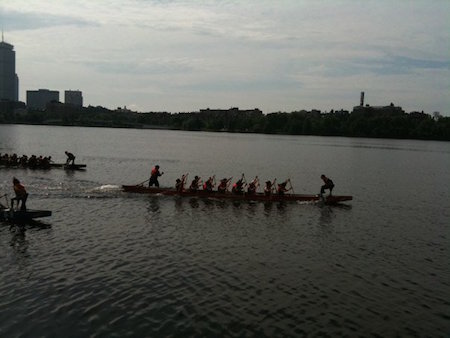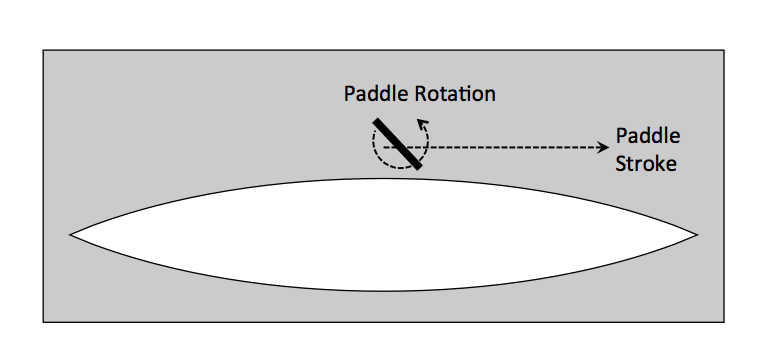
Good competitive paddling requires strength, timing, consistency, and teamwork. Initially, this may seem quite easy. Simply stick your paddle in the water and make the water go backward so that the boat moves forward. As it turns out, there are actually many different paddling strokes you can use depending on the situation.
Battling High Winds While Canoeing
Canoeing is one of my favorite hobbies. In fact, I used to paddle dragon boats competitively on the beautiful Charles River here in Boston. If you’re ever in the city on a nice summer day, I strongly encourage you to rent a canoe and paddle down the river.

Dragon boats on the Charles River.
Boston’s weather, however, can change rather quickly. While it may be calm when you begin moving down the river, high winds can pick up and start blowing your canoe all over the place. Every time you raise your oar out of the water, it will catch the wind. As you swing your oar forward, you will hit the crests of the small waves that are being kicked up. Such movement leaves you wet and, even worse, throws off the balance of the boat. How might you change your paddle stroke to regain control of the situation?
An experienced paddler would start to use the Indian stroke, also called the Canadian J-stroke — just one of the many kinds of canoe paddle strokes. This stroke moves the paddle backward in the typical power stroke. Without lifting the paddle out of the water, the paddler rotates their grip, such that the paddle’s blade is parallel to the direction of travel on the return stroke.
The advantage of the Indian stroke, nicely demonstrated here, is that the paddle blade is never exposed to the wind and does not strike any of the wave crests. While easy to perform at slow speeds, this stroke is rarely used in races. It requires exceptionally strong control of the paddle as well as a solid understanding of how to move the paddle through the water.
With COMSOL Multiphysics, you can analyze and improve upon your paddle stroke. We’ll show you how.
Modeling a Paddle Stroke with COMSOL Multiphysics
Let’s simplify things a bit. We will consider a simplified paddle stroke and model it in the 2D plane. Although it is assumed that there is no variation in the z-direction (the water depth), we can begin here to gain some insight. The model under consideration is comprised of a rectangular fluid domain that is filled with water. The example includes a canoe-shaped cutout as well as a rectangular cutout that represents the paddle.
We want to model the paddle moving back and forth along a known path and rotating about its center. We can specify the fluid velocity at the paddle blade based on the known translational and rotational movement. The fluid velocity at the canoe wall is zero and open boundary conditions surround our model space.

The modeling domain considers the paddle translating and rotating next to the canoe. The boat moves from left to right.
Previously on the blog, we highlighted approaches for modeling general translations of domains as well as rotations and linear translations. A combination of these techniques can be used to model the deformation and rotation of the paddle. The animation below illustrates such techniques, showing the mesh through one full stroke. The mesh faces can slide relative to one another, yet still maintain continuity of the solution across these disjoint mesh interfaces.
An animation depicting moving mesh. A very coarse mesh is shown for illustrative purposes.
Since the translation and rotation of the paddle blade are now completely defined, there is only one thing left to solve: the Navier-Stokes equations on the moving domains. In this analysis, we will assume laminar flow. We will also assume that the canoe is quite heavy and is not yet moving. The animation below allows you to visualize the results for the first few strokes.
Flow during the paddle stroke.
Now that you can visualize the flow patterns around the paddle blade, albeit in this somewhat simplified case, how might you improve your own stroke? Once you determine your optimal stroke, you might even want to consider joining a competitive dragon boat team here in Boston, or elsewhere — a healthy and fun way to put your COMSOL Multiphysics modeling skills to use!
Can you think of other situations in which this approach could be applicable? We are happy to hear your feedback. If you are interested in using COMSOL Multiphysics to model your paddle, or perhaps another form of fluid-structure interaction, please contact us.




Comments (8)
Anu Das
October 21, 2015Dear Walter
May I get your email id plz. I have a specific issue with coupling physics. I wanna share the modelling steps (ppt- 4 slides) with you so that i can locate the error in the model file i created.
Thanks a lot in advance.
Fanny Griesmer
October 21, 2015 COMSOL EmployeeHello Anu,
Thank you for commenting. If you have more general questions, feel free to contact your COMSOL support team and they will assist you with technical issues.
Anu Das
October 22, 2015Dear Fanny
I shared with the support team but there is no progress. May I plz get the email id of dr walter frei plz?
Regards,
– Anu
Fanny Griesmer
October 23, 2015 COMSOL EmployeeHello Anu,
It’s COMSOL’s policy not to give out personal emails on public forums. Please continue to work with support on your case.
VLC
October 28, 2015Hello Mr. Frei,
is it possible to get the comsol file of the descriped simulation?
I have a problem which might be solved with this kind of approach.
thank you.
kind reagards
Jan grabowsky
Fanny Griesmer
October 28, 2015 COMSOL EmployeeHi Jan,
Thank you for your comment. Please contact your COMSOL support team directly so they can help you.
Online support center: http://www.comsol.com/support
Email: support@comsol.com
Vaishali Upadhye
February 2, 2016Dear Fanny,
I wanted to see the webinar/ online Tutorial: Piezoacoustic Optimization conducted by you. It is not available on comsol website could you share it please
vaishali.upadhye@gmail.com
Fanny Griesmer
February 2, 2016 COMSOL EmployeeHello Vaishali,
I have forwarded your request to your local sales representative, who will be in touch with you.